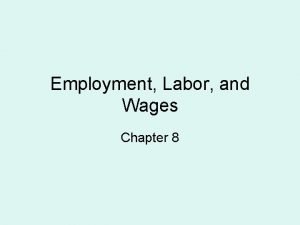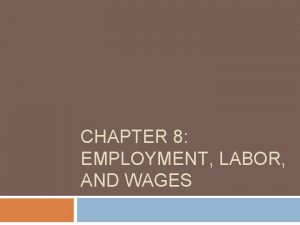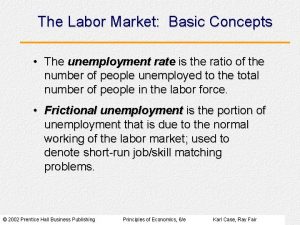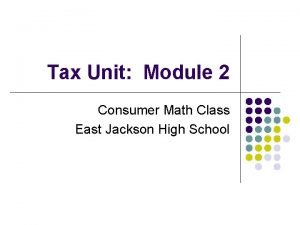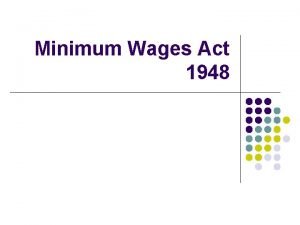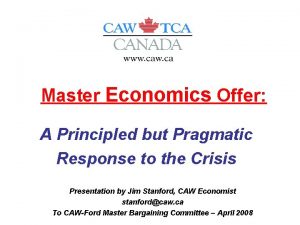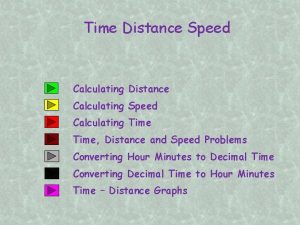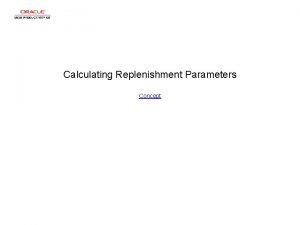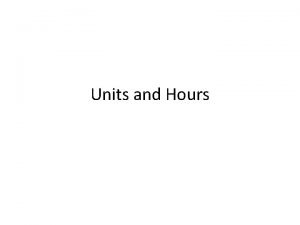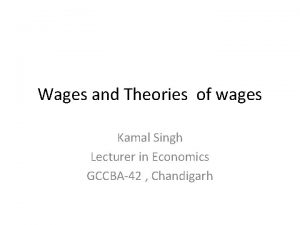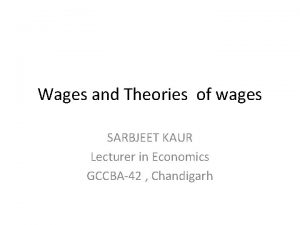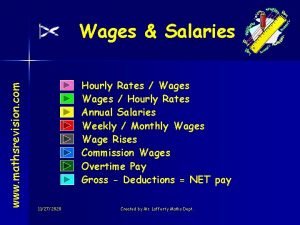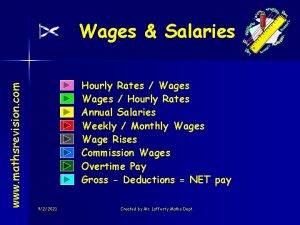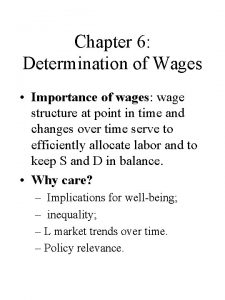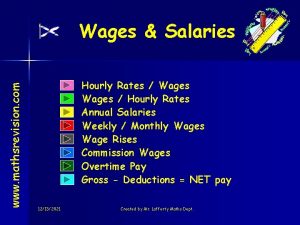Measuring wages and working hours and calculating wages
























- Slides: 24

Measuring wages and working hours, and calculating wages in Poland Magdalena Andrałojć The Poznan University of Economics Magdalena Andrałojć, Amsterdam 27. 01. 2005

The outline of presentation 1. The most popular contracts concerning work in Poland 2. Gross and net wage 3. Working hours 4. Some Polish data – Central statistical office 5. Summary - comments to WIQ Magdalena Andrałojć, Amsterdam 27. 01. 2005

The most popular contracts concerning work in Poland 1. On the basis of civil law n n Special contract 1 - contract by results „Umowa o dzieło” Special contract 2 - free-for-task agreement „Umowa zlecenie” 2. On the basis of labour law n contract of employment – permanent contract, fix-term contract, replacement contract Magdalena Andrałojć, Amsterdam 27. 01. 2005

Contracts concerning work indicated in WIQ Question E 01 and E 03 „what kind of contract do you have? n permanent contract (labour law) n fixed-term contract (labour law) n apprentice, trainee (civil law, no-name agreement) n replacement contract (labour law) n community work scheme / subsidized employment (labour law) n contractor / labour-only subcontractor ( contract by results, free-for-task agreement - civil law) n contract with temp agency (labour law) n seasonal work (labour law, sort of fix-term contract) Magdalena Andrałojć, Amsterdam 27. 01. 2005

Contract by results 1. 2. 3. 4. 5. 6. 7. There are two partners of the contract – contractor, who agrees to do some work and client who agrees to pay for results of this work (e. g. writing a book) It is not subordinate relationship Client has to pay for result Written form is required The time limit is agreed, but working hours are not The cost of achieving income is 20% (without copyright) or 50% (with copyright) of contractor’s income – this amount diminishes the basis of tax calculation Social security contribution is not paid Magdalena Andrałojć, Amsterdam 27. 01. 2005

Free-for-task agreement 1. 2. 3. 4. 5. 6. 7. There are two partners of the contract – contractor, who agrees to do some work and client who agrees to pay for doing this work (e. g. teaching), contractor gives a promise to do the work as good as he can, but doesn’t give a promise to achieve results It is not subordinate relationship Client doesn’t have to pay if the partners agreed so Written or verbal form The time limit is agreed, but working hours are not The cost of achieving income is 20% (without copyright) or 50% (with copyright) of contractor’s income There is an obligation to pay social security contribution Magdalena Andrałojć, Amsterdam 27. 01. 2005

Contract of employment 1. 2. 3. 4. 5. 6. 7. There are two partners of the contract – employee, who agrees to do some work and employer who agrees to pay for work and secure the good working condition It is subordinate (work) relationship Employer has to pay agreed amount of money for employee in agreed period of time Written form is required Working hours are agreed The cost of achieving income is 102, 25 PLN per month (1227 PLN per year) There is an obligation to pay social security contribution Magdalena Andrałojć, Amsterdam 27. 01. 2005

Contract by result, free-for-task agreement, and contract of employment compared Type of contract Legal basement Object of Relationship the contract Secured good working condition Form of agreem ent Working hours Cost of achieving income Social security contributi on and health Contract by results Civil law Results of work Equal (contractor – client) No Written Not agreed 20% 50% No Free-fortask agreeme nt Civil law Doing a work Equal (contractor – client) No Written or verbal Not agreed 20% 50% Yes Contract of employm ent Labour law Doing a work Dependence No (employee – employer) Written Agreed 102, 25 PLN per month (1227 per year) Yes Magdalena Andrałojć, Amsterdam 27. 01. 2005

Does question E 03 „what kind of contract do you have? ” correspond with A 01 „Which description matches best your current employment activity? ” If yes, who has to answer E 03? A 01 • Employee Contract by results Free-for- task agreement • Family worker / working for family business • Self- employed • Apprentice / trainee • In a job creation scheme • School pupil, student in full-time education • Unemployed / looking for a job • Sickness benefit / incapacity for work E 01 and E 03 • permanent contract (labour law) • fixed-term contract (labour law) • apprentice, trainee (civil law) • replacement contract (labour law) • community work scheme / subsidized employment (labour law) • contractor / labour-only subcontractor (civil law) • contract with temp agency (labour law) • seasonal work (labour law, sort of fix-term contract) • other Magdalena Andrałojć, Amsterdam 27. 01. 2005

Gross and net wage NET WAGE = GROSS WAGE – STATUTORY DEDUCTION Statutory deduction: 1. Social security contribution (pension contribution, sick live contribution) 2. Obligatory health contribution 3. Tax deduction (tax deduction is made every month, but at the beginning of each year employee has to square up with the Internal Revenue/Taxation Office previous year – employee can use tax relief and then he receive some money back) Magdalena Andrałojć, Amsterdam 27. 01. 2005

Social security contribution 18, 71% of pay for worked time (contracted pay + overtime – pay getting during sick live) up to 33 days in a year pay is covered by employer, from 34 day employee gets sickness benefit from Social Security) Magdalena Andrałojć, Amsterdam 27. 01. 2005

Obligatory health contribution Basis of health contribution = income (contracted pay + overtime + pay getting during sick live) – social security contribution 2005 – 8, 5% of basis (7, 75% is deducted from the tax and 0, 75% is deducted from income after tax – decreasing net wage) 2006 – 8, 75% (7, 75% from tax, 1% from income after tax) 2007 – 9% (7, 75% from tax, 1, 25% from income after tax) Magdalena Andrałojć, Amsterdam 27. 01. 2005

Tax deduction Basis of income tax = income (contracted pay + overtime + pay getting during sick live) – social security contribution - cost of achieving the income (20% or 50% or 102, 25 PLN per month depends on the contract) Magdalena Andrałojć, Amsterdam 27. 01. 2005

Income tax Progressive income tax scale, 4 tax rate – 19%, 30%, 40%, 50% free tax quota – 2 790 PLN per year (232, 5 PLN per month) it means that we can deduct from calculated tax 530, 08 PLN per year (2 790 PLN*0, 19) or 44, 17 PLN per month (232, 5*0, 19 ) income scale up to 37 024 PLN per year (3 085, 33 PLN per month) 19% tax basis – 530, 08 PLN per year or (44, 17 PLN per month) 37 024 – 74 048 per year (3 085, 33 – 6 170, 67 per month) 6 504, 48 + 30% surplus over 37 024 per year (542, 04 + 30% surplus over 3 085, 33 per month) 74 048 – 600 000 per year (6 170, 67 – 50 000 per month) 17 611, 68 + 40% surplus over 74 048 per year (1467, 64 +40%) Over 600 000 PLN per year (50 000 per month) 227 992, 48 + 50% surplus over 600 000 per year (18999, 37 + 50% surplus per month) Magdalena Andrałojć, Amsterdam 27. 01. 2005

Gross and net wage Contract by results Net = gross - tax deduction (using 20% or 50% of cost of achieving the income) Free-for- task agreement Net = gross – (social security contribution + obligatory health contribution + tax deduction) using 20% or 50% of cost of achieving the income Contract of employment Net = gross – (social security contribution + obligatory health contribution + tax deduction) cost of achieving the income 102, 25 PLN per month Magdalena Andrałojć, Amsterdam 27. 01. 2005

Working time and wage estimation Contract by results Free-for- task agreement We can estimate hourly wage using question E 22 „On which payment period was your last wage based? ” + usual hours on the last project It is difficult to estimate an annual wage We can treat them as self-employed – ask them for annual earnings or just exclude them Magdalena Andrałojć, Amsterdam 27. 01. 2005

Working time and wage estimation Contract of employment Calculation using contractual (standard) hours + paid overtime Standard working day = 8 hours Standard working week = 5 days Standard working month = 21 days Standard working year = 251 days It means 114 days off (103 days of weekends + 11 statutory free days) Almost every third day!!! + 23 days of paid holidays Magdalena Andrałojć, Amsterdam 27. 01. 2005

Measuring wages in national survey – Central Statistical Office Structure of wages by occupation in October 2002 (2004 is coming soon) Monthly gross wage = contracted pay (including flat wages and salaries, overtime bonuses, functions, seniority bonuses) + overtime + payments for periods exceeding one month in amount due to one month (e. g. one third of the quarterly premium, one sixth of the last paid semiannual premium, one twelfth of the annual premium or bonuses) + payments from balance surplus in cooperatives and from profit for distribution in enterprises Monthly gross wage doesn’t include payments such as: anniversary prizes, gratifications, retirement severancepays, compensations for lost vacations. Magdalena Andrałojć, Amsterdam 27. 01. 2005

Gross monthly wage in PLN according to age and gender, Poland 2002 Magdalena Andrałojć, Amsterdam 27. 01. 2005

Gender pay gap Magdalena Andrałojć, Amsterdam 27. 01. 2005

Gross monthly wage in PLN according to age and gender, Poland 2002 Magdalena Andrałojć, Amsterdam 27. 01. 2005

Gender pay gap Magdalena Andrałojć, Amsterdam 27. 01. 2005

Summary – comments to WIQ 1. 2. 3. 4. 5. Indicate in questionnaire (question A 1) contract by results and free-for-task agreement – routing similar to self-employed, some more question is needed (e. g. the time of starting and ending the project) or just thank them for interest If we want to convert gross to net information about cost of achieving the income are needed For calculation hourly wages use contractual monthly hours with and without paid overtime Include in the calculation wages from the main job only In question E 29 don’t ask about annual bonuses, but indicate them only in E 31 and ask „how much” Magdalena Andrałojć, Amsterdam 27. 01. 2005

Thank you! Any questions? Magdalena Andrałojć, Amsterdam 27. 01. 2005
 Payment systems and working hours
Payment systems and working hours Eti base code
Eti base code Hot working and cold working difference
Hot working and cold working difference Advantages of hot working over cold working
Advantages of hot working over cold working Machining operations
Machining operations Contoh hot working
Contoh hot working Hard work vs smart work presentation
Hard work vs smart work presentation Factors influencing wage and salary administration
Factors influencing wage and salary administration Section 1 guided reading and review labor market trends
Section 1 guided reading and review labor market trends Chapter 8 employment labor and wages
Chapter 8 employment labor and wages Chapter 9 section 2: labor and wages worksheet answers
Chapter 9 section 2: labor and wages worksheet answers Guided reading activity 8-3 labor and wages answers
Guided reading activity 8-3 labor and wages answers Objectives of payment of wages act 1936
Objectives of payment of wages act 1936 Prop 206 pto
Prop 206 pto Workers wages and benefits module
Workers wages and benefits module Chapter 8 employment labor and wages
Chapter 8 employment labor and wages Factors that determine wages
Factors that determine wages Sticky price theory of aggregate supply
Sticky price theory of aggregate supply Sticky wages
Sticky wages Tips earned by a server in a fashionable restaurant
Tips earned by a server in a fashionable restaurant Origin
Origin The minimum wages act 1948
The minimum wages act 1948 Caterlink wages
Caterlink wages The minimum wage act 1948
The minimum wage act 1948 Low wages high rent political cartoon meaning
Low wages high rent political cartoon meaning









